Forty Guns (1957)
Directed by: Samuel Fuller
Written by: Samuel Fuller
Starring: Barbara Stanwyck, Barry Sullivan, Dean Jagger, John Ericson
USA
AVAILABLE ON BLU-RAY: November 11th, in the FULLER AT FOX, FIVE FILMS 1951-1957 Boxset, from EUREKA ENTERTAINMENT
RUNNING TIME: 80 mins
REVIEWED BY: Dr Lenera, Official HCF Critic
Reformed gunslinger Griff Bonnell, accompanied by his brothers Wes and Chico, arrives in the town of Tombstone, Arizona, looking to arrest Howard Swain for mail robbery. Swain is in the pay of landowner Jessica Drummond, who runs the town with an iron fist, permitting it to be terrorised and trashed by her brother, Brockie Drummond, and his boys. Wes falls in love with Louvenie Spanger, the daughter of the town gunsmith, so he decides to settle down and become the town’s marshal. And then Griff and Jessica fall for each other, but some of Jessica’s hired guns don’t want this match to happen….
Seeing as I’m going through a bit of a western phase at the moment, I was most interested to see what Fuller would do with the genre, though Forty Guns is actually one of four ‘oaters’ that he made, the others being I Shot Jesse James, The Baron Of Arizona and Run Of The Arrow, the latter being the first film to use blood squibs to convey the realistic impact of a bullet. As I write with Eureka’s Blu-ray having just finished playing, I’m not entirely sure what I’ve just watched. Is it Fuller sending up the genre’s conventions, or is it Fuller trying to make a serious statement on not just the western but things like violence, the gun and even gender? At times the dialogue is quite profound, and at times it’s very cheesy and so full of sexual innuendo that it’s a wonder that the usual moral guardians didn’t create a stink when it first came out. Realism and believability jar with an increasingly unlikely story and down right strange, exaggerated scenes like a man walking up to his rival, taking way longer than it would take to cover the hundred yards shown, until finally reaching him and not shooting but knocking him down with the butt of his gun. And all this filmed with Fuller’s usual expertise, still showing a young person’s excitement in cinema, and here a serious leaning to film noir and the florid melodrama of Douglas Sirk. I veered from engrossment to admiration to laughter to occasional bafflement. And yet I don’t mean all this as a problem. I had a total ball with it, and often that’s all that counts, though I do really recommend that you watch the five films in this set in order, because I do think that you really need to be used to Fuller’s world and way of seeing and showing things, to be in his headspace, to truly appreciate this one!
The inspiration was, as you have probably guessed when reading my synopsis of the first third, the real-life Gunfight at the O. K. Corral where four lawmen consisting of members of the Earp family except for Doc Holliday duked it out with five outlaws, three of them Clantons. It remains probably the most famous shootout in the history of the American Wild West, and has been adapted into many films with varying degrees of accuracy, the best known being My Darling Clementine, Gunfight At The O.K. Carrol and Tombstone. Fuller’s film unsurprisingly takes a hell of lot of liberties, even having one of the Clantons be female, but there are a few direct references to what really happened, like a “murdered” sign being displayed on a corpse. Fuller initiated the project which went under the working title of Woman With A Whip. It was shot in just ten days on a very low budget. While filming one scene, Barbara Stanwyck’s stunt woman refused to allow herself to be dragged along by a horse, saying that it was too dangerous. The 49-year old Stanwyck went and did it by herself, getting some bruises and scrapes for her efforts. Fox forced Fuller to alter his original ending [SPOILER – Griff was original meant to accidentally kill the person someone is using as a shield – SPOILER END]. The film made back its money and then some, but critical response in the US wasn’t positive. Of course in France, waking up earlier than most to Fuller’s peculiar brand of genius, it was much praised.
A wide shot of the countryside opens the film, though it’s kind of deceptive because most of the film will play out in the streets and houses of Tombstone. A wagon with three men in it is frantically inter-cut with the legs of the galloping horses of the Forty Guns of the title, something that Clint Eastwood repeated at the beginning of Pale Rider. The riders ride past the stagecoach for what seems like ages as its horses jump in fear. The latter is a believable thing you don’t often see in this kind of film, but there’s something absurdist about the scene too. These two seeming extremes – believability and absurdity – remain in conflict throughout the rest of the movie, and after a while you get used to it and the two things begin to compliment each other in a strange way. We get the opening titles over which a piece of music begins in very melodramatic vein before seguing into a variation on ‘She’ll Be Coming Round The Mountain’. In fact music is used oddly soon after when we hear someone singing a song about Jessica which has to heard to be believed, beginning with the words, “she’s a high-riding woman with a whip”. It seems like it’s part of the soundtrack, being used in a High Noon fashion, but then it’s revealed to be sung and played on the guitar by one of the film’s characters, Barney Cashman. Anyway, it’s not long before we get some violence as Jessica’s drunken, loutish brother Brockie pours coffee over the face of the vision-impaired Marshall Chisolm, knocks him to the ground, then shoots him in the leg. We later find out that a woman [named Rio in the credits] is the course of this, leading to a strange scene that some modern viewers may find uncomfortable. Brockie slaps her twice when she refuses his orders to do something, then his rival for her affections Chisolm pulls him off her. After an exchange, Chisolm goes away and Brockie and Rio begin to kiss, she seeming to passionately initiate it. Well I’ve noticed two or three other Fuller films to have love scenes that are rather – violent. Should one read something into this?
Our hero Griff doesn’t want to get involved. “Not my fight” he says, but when some of Brockie’s mates start trashing the town, he has no choice. However, he hasn’t used a gun in a long time and doesn’t want to begin doing so now. Romance flourishes when Wes and gunmaker’s daughter Louvenie Spanger become attracted to each other when she’s fitting him for a rifle, and the two look like they’re about to get down to ‘it’ there and then in her dad’s shop – preceded by nothing less than a pre-007 view through a gun barrel! The two decide to marry. And then there’s Griff and Jessica, who fall for each other after she’s been dragged by a horse during a tornado – yes, a tornado that just appears and looks remarkably convincing I must say. I reckon that shots of a real one were used for the distant shots and matted in, though it’s hard to tell, it looks seamless! Later on, she’s after his gun. “Can I feel it”? “Uh-ha”. Just curious”. “It might go off on your face”. Carry on Cowboy isn’t too far away, and I don’t mean that as an insult by the way. On the other hand their first kiss is preceded by the oh-so romantic line, “my throat’s dry, I’m talking too much”. As for the third brother Chico, he wants to be a gunfighter but is told this is not a good aspiration to have by Griff and decides to leave town. But two of Jessica’s dragoons, Logan, and Savage, want to put a stop to all this loving, and things heat up more and more and not entirely as expected. It really is very much about the gun, and not always positively. There’s dialogue that mentions the passing of the west and guys like Griff being outdated, and a scene where Chico kills someone and Griff is certainly not happy with it, seeing it as the start of a slippery slope. Of course you know that the gun is going to end up righting wrongs, yet some tragedy does take place too.
We seem to get a final scene, and then another final scene that would have ended things quite neatly as it involves one of the two major female characters seeking solace with the other – and then another final scene that virtually replays the ending of Shane before it’s resolved more conventionally, albeit at a far distance so all you see are two little dots as figures. Can one read the shooting of this scene as symbolic of Fuller’s reluctance to shoot it? Possibly. But then unusual angles and shot composition are employed throughout, some to reinforce points of the story or the characters, and some just for the hell of it, like when somebody is engaged in a shoot-out with somebody much higher up than him and the person below is the one shot from the ground up. Sometimes fades are lingered upon, like Jessica’s huge face remaining in the sky as her Guns are riding around. Other moments go full-on film noir with emphasis on shadows and black lines and patches falling across faces. And then there are two tracking shots that I won’t forget in a hurry. One lasts over five minutes and follows the three brothers as they walk through the town. The other is when an arrest warrant is passed between the Guns as they sit at a table that seems to be endless as the camera follows the passage of the warrant. How on earth did Fuller and cinematographer Joseph F. Biroc manage such stuff on such a tight schedule and budget? It’s astonishing.
Western conventions and even cinematic conventions are played with. Most films would have had the two female characters shown taking baths, but here we have not one but two quite lengthy scenes of our brothers bathing. There’s plenty of funny banter, including this forerunner to a Chuck Norris joke. “I was bitten by a rattlesnake when I was fifteen”. “I’ll bet that rattler died”. Yet despite the madness of some of what we see and even hear, we’re given enough time to feel when we need to. The most notable example of this is when we hear the film’s second, far more serious than the first, ballad over a simple tracking shot beginning with a medium, low-angle view of a widow standing next to a very polished, horse-drawn hearse, then left to Barney the singer, and back again. Simple and effective. And, as he’s shown before, he tries to treat death as realistically for the time as he could, with one character dying foaming at the mouth and with his eyes wide open. This is despite some things being well nigh impossible to swallow, particularly Jessica. Would a woman in the west really have been able to be in charge of fourty men in this manner? And her actions become increasingly odd, though of course that may well have been intentional. Thank goodness that Stanwyck is as hypnotic as ever, and unusually sympathetic too, something which makes up for Barry Sullivan’s usual faint dullness, while Dean Jagger is peculiarly sympathetic as the corrupt and ineffectual Sheriff Ned Logan who has a hankering after Jessica. Forty Guns is rather barmy yet perhaps also kind of brilliant.
This time it was Criterion who first put this out on Blu-ray, followed shortly after by France’s Carlotta Films, but again we have absolutely terrific picture quality with sharpness, grain, detail and blacks all looking almost perfect. I won’t waste time saying any more because I have no complaints whatsoever.
Eureka have substituted one Criterion featurette for another newly produced one, while the Carlotta had two others. The 1969 audio interview at the National Film Theatre plays over the film like a commentary. It’s an absolute joy to listen to, a clearly ‘very happy to be there’ Fuller answering mostly intelligent [if sometimes hard to hear] questions from the presenter and members of the audience at great length. He’s a great raconteur, and while only briefly dealing with Forty Guns, you get a lot of interesting stuff, like how he started out in the film business making lots of money from scrips that went un-filmed, the studio re-editing of his film Shark, and how he doesn’t consider his films violent – even though the evidence of course points to the contrary! A Fuller Life has various luminaries including Wim Wenders, Joe Dante and Mark Hamill read excerpts from his memoirs while shots and footage taken by Fuller is seen. Even though it takes a while to get to his movies where it skips forward quite a lot, don’t be put off – his war [“organised insanity” he appropriately calls it] writing is well worth a listen to, with some powerful stories like when his group encountered a Fascist-hating girl in Sicily, and how he got used to killing. His experiences caused him to have life-long nightmares, but by some kind of compensation he got a sexy young wife when he was in his ’60s too. What a life. And a Must Watch. And finally we get Jean-Louis Leutrat discussing certain aspects of Forty Guns, in particular its attention to detail, and its influence on film-makers as different as Jean-Luc Godard and Sergio Leone. While there’s less overall material about the actual film, this is another fine package overall.
While I haven’t seen Pickup On South Street, the other four films in the Fuller At Fox boxset all show a film-maker able to straddle artistry and entertainment at the same time with great ease. Fans of Fuller will need no further recommendation, but I think that many newcomers will be impressed by the skill, style, invention yet also accessibility of these films. The set comes Highly Recommended.
FULLER AT FOX, FIVE FILMS 1951-1957 LIMITED EDITION BOX SET [2000 UNITS, INDIVIDUALLY NUMBERED] SPECIAL FEATURES
*All five films presented on Blu-ray in 1080p, with Fixed Bayonets!, Pickup on South Street, Hell and High Water, and Forty Guns presented from Fox’s stunning 4K restorations, with House of Bamboo presented from a 2K restoration
*Original, uncompressed, monaural soundtracks for all films
*Optional English SDH available for all films
*FIXED BAYONETS! – audio commentary by film scholar Adrian Martin
*PICKUP ON SOUTH STREET – Interview with critic, filmmaker and programmer Kent Jones [32 mins]
*PICKUP ON SOUTH STREET – Interview with critic François Guérif [24 mins]
*PICKUP ON SOUTH STREET – “Cinema Cinemas” French TV interview with Samuel Fuller [12 mins]
*HELL AND HIGH WATER – Brand new audio commentary by author Scott Harrison
*HELL AND HIGH WATER – A documentary on lead actor Richard Widmark [45 mins]
*HOUSE OF BAMBOO – Audio commentary with Film Historians Julie Kirgo and Nick Redman
*HOUSE OF BAMBOO – Audio commentary with Film historians Alain Silver and James Ursini
*HOUSE OF BAMBOO – a brand new video essay by David Cairns looking at Samuel Fuller’s films produced for Twentieth Century Fox.
*FORTY GUNS – Audio interview with Samuel Fuller from 1969 at the National Film Theatre in London [80 mins]
*FORTY GUNS – A Fuller Life [80 mins], a feature-length documentary directed by Samantha Fuller
*FORTY GUNS – Interview with film critic Jean-Louis Leutrat [17 mins]
*Original theatrical trailers for all five films
A 100-PAGE PERFECT BOUND COLLECTOR’S BOOK featuring essays by Richard Combs, Murielle Joudet, Philip Kemp, Glenn Kenny, and Amy Simmons; excerpts from Fuller biography A Third Face; and rare archival imagery

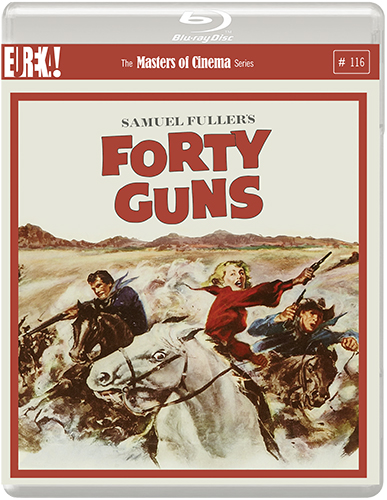
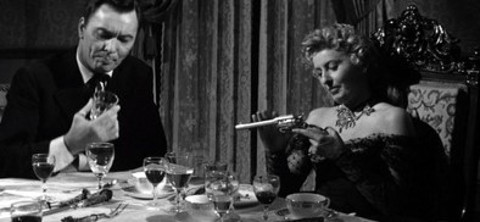
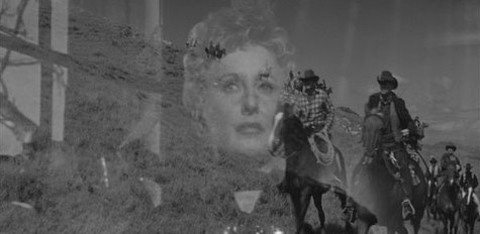



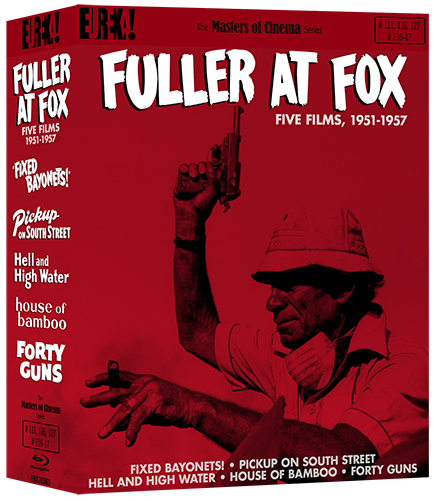

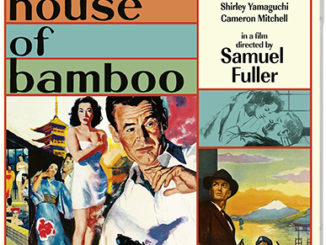
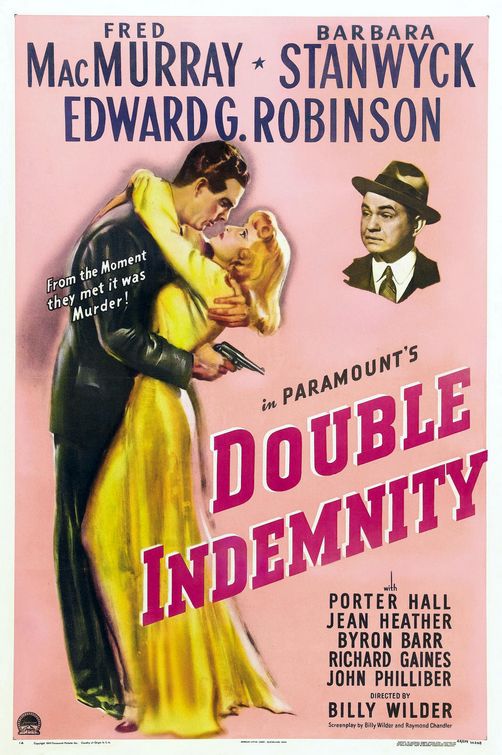
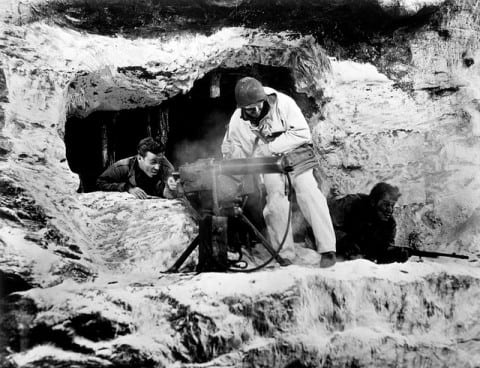
Be the first to comment